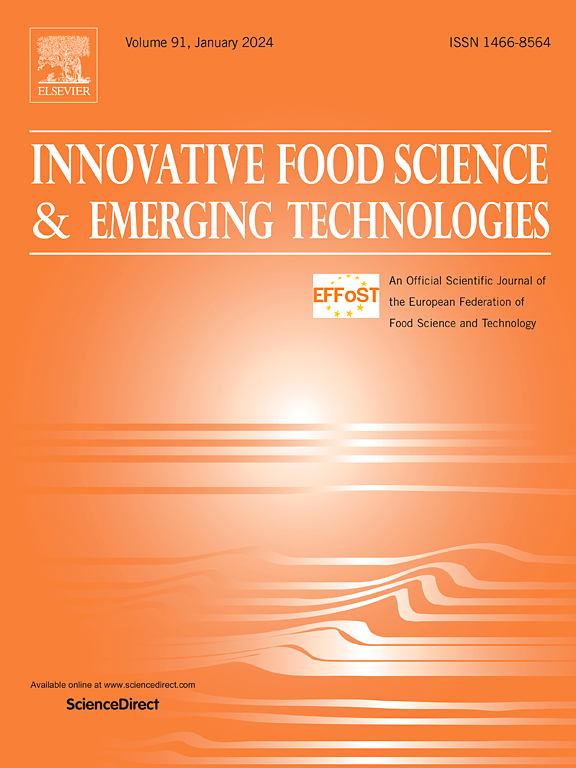Experimental investigation on the continuous-flow RF treatment of fluid foods under screw conveying: A case study of extracting apple pectin
IF 6.3
1区 农林科学
Q1 FOOD SCIENCE & TECHNOLOGY
Innovative Food Science & Emerging Technologies
Pub Date : 2025-04-25
DOI:10.1016/j.ifset.2025.104030
引用次数: 0
Abstract
Radio frequency (RF) treatment has been widely used in food processing. However, research on the continuous flow RF treatment (CFRFT) of fluid foods is still limited. This study aims to develop a screw conveying based continuous-flow system and using a pectin extraction system composed of apple pomace-citric acid solution mixture (APCASM) as a liquid model to investigate heating characteristics and efficiency of pectin extraction under CFRFT conditions. The results indicated that RF heating rate of APCASM increased gradually with the increase of liquid level, screw rotational speed, and flow rate, respectively. The optimal heating uniformity of APCASM was obtained at liquid level of 58 mm, screw rotation speed of 10 r/min, and flow rate of 780 mL/min. Compared with commercial apple pomace pectin (APP), APP obtained from continuous flow RF-assisted extraction (CFRFAE) exhibited slightly lower galacturonic acid and degree of esterification content, but superior antioxidant capacity and emulsifying properties. Furthermore, CFRFAE has no significantly impact on the primary structure of APP. Considering both yield and energy consumption, a smaller electrode gap may be a better choice for CFRFAE of pectin. The results from this study would offer fundamental insights and recommendations for using screw conveying systems in the CFRFT of liquid foods.
螺旋输送下流体食品连续流射频处理的实验研究——以提取苹果果胶为例
射频处理技术在食品加工中得到了广泛的应用。然而,对流动食品的连续流射频处理(CFRFT)的研究仍然有限。本研究旨在开发一种基于螺旋输送的连续流系统,并以苹果渣-柠檬酸溶液混合物(APCASM)组成的果胶提取系统为液体模型,研究CFRFT条件下果胶的加热特性和提取效率。结果表明:随着液面、螺杆转速和流量的增加,APCASM的射频加热速率逐渐增大;在液面为58 mm、螺杆转速为10 r/min、流量为780 mL/min时,APCASM的加热均匀性最佳。与商品苹果渣果胶(APP)相比,连续流射频辅助提取法(CFRFAE)得到的苹果渣果胶半乳糖醛酸含量和酯化程度略低,但抗氧化能力和乳化性能较好。此外,CFRFAE对APP的一级结构没有显著影响。从产率和能耗两方面考虑,较小的电极间隙可能是果胶CFRFAE的较好选择。本研究的结果将为在液体食品的cffrft中使用螺旋输送系统提供基本的见解和建议。
本文章由计算机程序翻译,如有差异,请以英文原文为准。
求助全文
约1分钟内获得全文
求助全文
来源期刊
CiteScore
12.00
自引率
6.10%
发文量
259
审稿时长
25 days
期刊介绍:
Innovative Food Science and Emerging Technologies (IFSET) aims to provide the highest quality original contributions and few, mainly upon invitation, reviews on and highly innovative developments in food science and emerging food process technologies. The significance of the results either for the science community or for industrial R&D groups must be specified. Papers submitted must be of highest scientific quality and only those advancing current scientific knowledge and understanding or with technical relevance will be considered.

 求助内容:
求助内容: 应助结果提醒方式:
应助结果提醒方式:


